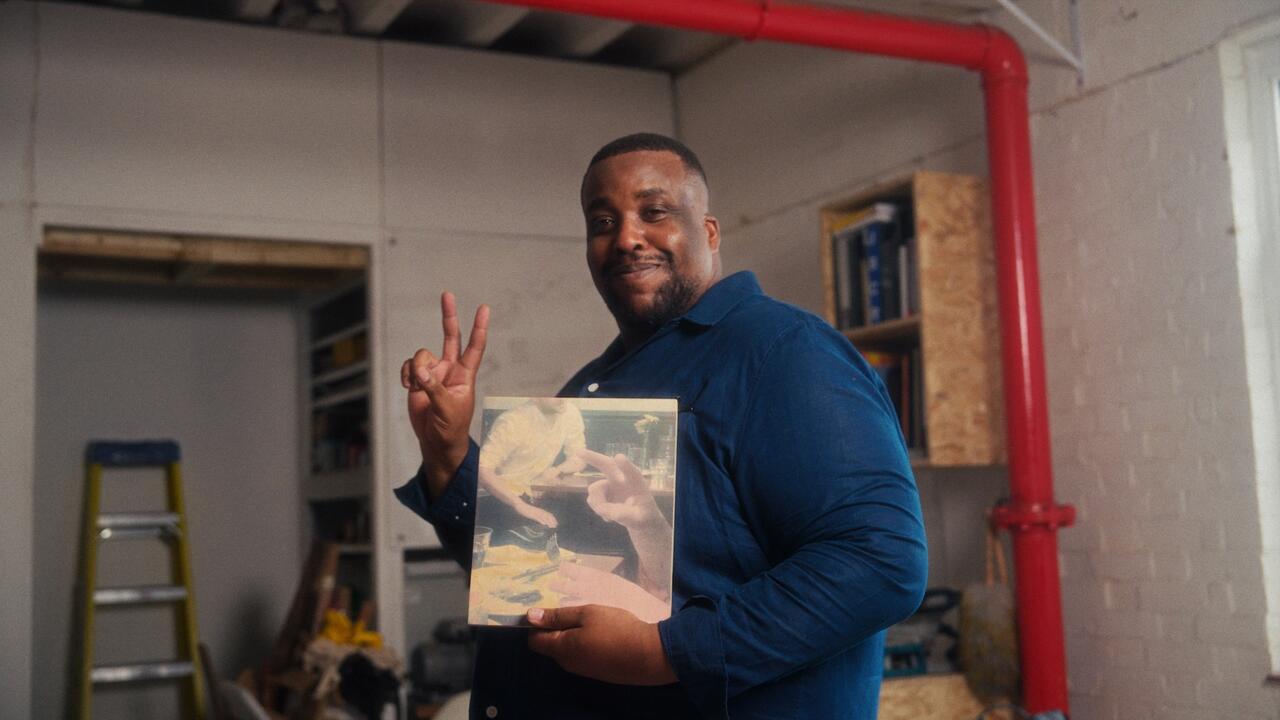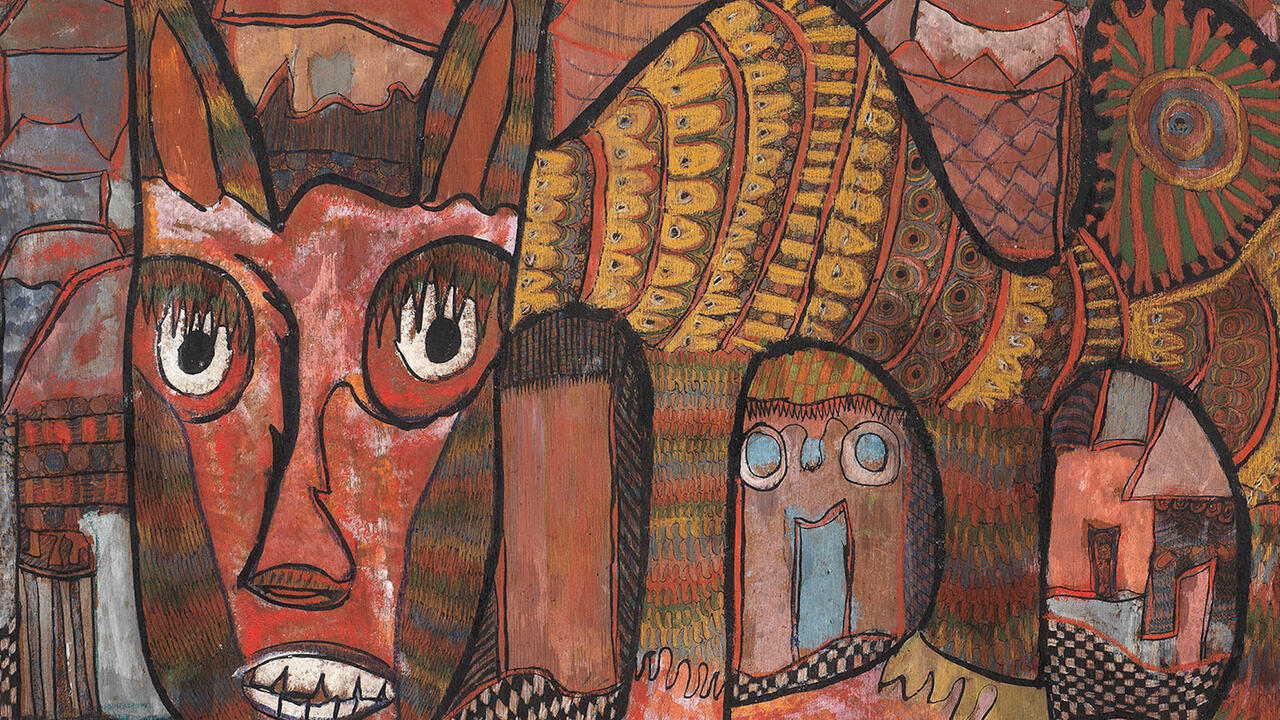Speaking in Tongues
Richard Wentworth
Richard Wentworth
We read the world narratively all the time... it's what actually gives us some sort of confidence in the world. Certain arrangements of things appear normal, and we take them for granted.1
Richard Wentworth's sculptures frequently embody what could be described as very 'human' qualities. The type of objects found in each work and the way these elements are positioned, often suggest a certain movement, gesture or touch that is associated with everyday behaviour and actions. Looking at the work brings out a recognition, or rather a remembrance, of these actions as they may have been performed by the viewer, and helps to form a mental reconstruction of the events that took place during the making of the work.
Similarly, there is, running through the vocabulary of ready-made objects that appears in Wentworth's work, a line of narrative that describes the history of the objects' production. One group of items: buckets, water tanks, tin baths and metal dustbins, assert the way they are constructed in a flourish of rivets and soldered joints. The way that a bucket, for example, is made - by bending, rivetting and crimping flat sheets of steel - is a miniature narrative of its own about the way in which man handles certain materials and objects in the world. This process is reflected finally in the joints and seams of the objects, which seem to admit to the object's frailty and suggest that it could be 'undone' again. A similar sense of satisfaction in understanding how things are made is evident in the way Richard Wentworth makes sculpture: in almost total contrast to the seamlessness of most Modern objects, which appear to have popped out of nowhere and have no discernable point of origin, Wentworth's work is visibly handmade with a considerable degree of skill.
By way of contrast, injection moulded plastic buckets from Homebase, for example, tell a very different - though no less interesting - story of design and marketing decisions when dealing with a material that can be manipulated at high speed by machine into almost any shape, and in almost any colour. Moulded plastics have seams, but they are not the seams of joints in their own material, but the reflection of the moulds that formed them.
What I like doing is rather ordinary. I like the behaviour of materials. I like the way they make relationships and the way that some things are like other things, and other things are different.2
The techniques that Wentworth uses to make his work are often the same as the somewhat old-fashioned methods used to make the objects he selects from the world. At one time in this country, thousands of products were produced by similar means. Now global mass-production has rendered these methods obsolete and cost-inefficient. These more labour-intensive techniques have an air of self-sufficiency about them that is now associated mostly with 'third world' and less-developed countries that are unable to afford modern plant for their manufacturing processes. They are often processes used to repair objects, and the objects themselves are made of materials which lend themselves to repair rather than disposability. They are also techniques that are used to make new things out of discarded ones -- rather like certain Asian crafts, where a brass vase may once have been a discarded machine part, a sandal once a worn-out tractor tyre. Wentworth once spoke of his desire to visit Jerusalem, where, due to the necessity of repairing broken kitchen utensils, the Palestinians had mastered the difficult technique of soldering aluminium. Soldering is a typical example of such a process: itself a metal that is used to join two other metals, solder acts as a kind of mental thumb tack in a way that is impossible with a technique such as welding that actually fuses the materials together. The beakers of Lapse are anchored to their box-file with small blobs of solder that keep them in position, but do not lock them together for all eternity. Solder is a kind of glue that is able to join items made of disparate materials without affecting their identity as objects: things made of painted metal, such as a filing cabinet, can be joined to create a sculpture that can be described as made of red metal or green metal, for instance, rather than in a situation where sheets of steel are welded together and then painted afterwards -- homogenising the material into a new and self-contained entity. This creates a very different perception of the way in which objects work within Wentworth's sculpture as they tend to carry their identities and suggested functions with them into the realm of the art gallery.
Wentworth's recent works that use tinned food, such as Island and World Soup, have a similar feeling to them, brought about through the labels of the cans - their skins - which tell us what was once inside. The animals that were once packed in neat, geometric cylinders, retain their presence in the stylised depictions on the labels. The titles of Wentworth's sculptures - somewhat more obtuse labels - bring bundles of other information, references and associations to bear upon the work. Man and the Animals, a pair of labelled tins - one cat food, the other dog food - arranged on a galvanised plinth in the manner of Jasper Johns' Ballantine Ale cans, sums up the strange relationship between Man and our favourite domestic (packaged) animals, and the bizarre machinations of the pet food industry, which feeds chunks of animal X to animal Y.
Island and World Soup display the fascination with the way objects can fit together and the sense of satisfaction inherent in the exact joining of surfaces that has characterised much of Wentworth's sculpture. The edges of each can join precisely with the holes cut to accommodate them in the surrounding metal sheet that grips them with a cushioning seam of solder. This accuracy is important, not only in the sense of visual pleasure that is generated when things fit - and there is a pleasure in the continuous beading of solder that runs around the brass disc of Surd and joins it to its steel mate - but also in the way that this binds the items into a group -- a specific combination. Yet technical proficiency is always underplayed and acts in a manner analogous to that of hearing a fully-formed sentence rather than a fragmented string of words. The precise mating of forms carries a sense of intimacy with it that is also found in Lapse, and has much to do with the qualities that we find desirable, or undesirable, in items that we bring into contact with our bodies: in this case, the lips. The rims of the two beakers in Lapse have an alluring curvature that invites the touch and beckons the lips to drink. When the wrong qualities or textures are present in a familiar context, an adverse reaction is created: like the unpleasantness experienced in drinking from the cracked edge of a teacup or the chipped rim of a glass.
The way objects are arranged in Wentworth's work also bears a strong relationship with the fragility and precariousness of positioning found in the way we deal with objects in daily life. Placing a cup of coffee on top of a book that is just too narrow to hold it completely, is the kind of everyday balancing act that we perform without thinking, and which demonstrates, when we do think about it, just how well developed our sense of natural physics really is.
Often these qualities are combined with a related formal associations. Placed as if laid down to await future use, the two beakers in Lapse look like binoculars, yet do not invite their use in that manner. A single stainless steel beaker and an unglazed earthenware flowerpot are the same shape, and share a visual similarity, yet their differing sizes and textures mean that they are not interchangeable: drinking tends not to be associated with rough, porous surfaces. Paradoxically, these visual similarities force home what it is about the two objects that makes them different and unsuitable for each other's tasks.
This sense of recognition of difference is touched upon in another recent work, entitled Balcone: a kind of identity parade of farm implements, that plays upon the extraordinary diversity of tools created in different cultures in response to the same basic needs. Perhaps, if it can be said that there are typically English, or Italian, faces, that there may be typically English and Italian tools, whose differences are of variety rather than function. The differences in approach and end product are legible because we understand the needs that formed them. A Spanish hoe and a Dutch hoe may have variations in design, but they are both used to dig up weeds. There is a certain cultural pleasure in discovering their differences, and a sense of satisfaction in the fact that we can identify the items at all.
One of the most surprising aspects of Wentworth's sculpture is its very legibility . This is echoed in the photographs from the series Making Do and Getting By - Wentworth's global mapping of imaginative incident - where the same attempts to wedge things open, prevent access and keep things dry are found solved in very similar ways from Barcelona to Peking. Local differences add colour and provide insights into how variables like climate, housing and public facilities may differ from country to country, but the overall impression is one of the extraordinary similarity of situation that people find themselves in the world over, and have to come to terms with using their own devices when readymade solutions are not to hand.
1. 'Needs Must: Richard Wentworth interviewed by Melina Kalinovska', Richard Wentworth, Riverside Studios, 1987
2. Ibid.
















